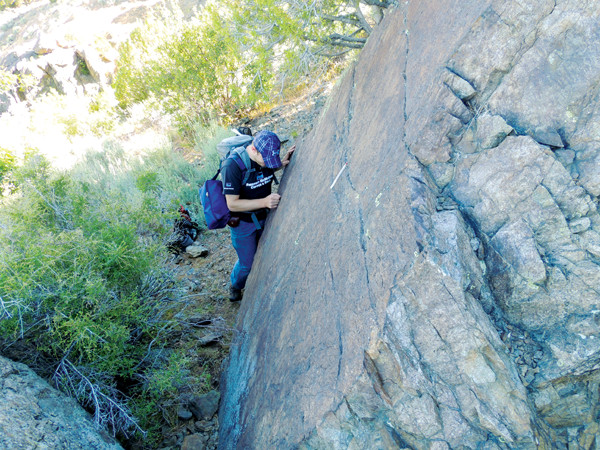
by Allison Mills Monday, October 6, 2014

Geologist Mitch Prante examines thin hematite layers on a fault surface that recorded ancient seismicity in the Wasatch Fault Zone in Utah. Credit: Jim Evans.
Although iridescent spots on rocks in Utah’s Wasatch Fault Zone were first recognized two decades ago, scientists haven’t understood their origin, until now. New research shows that the iridescence appears on fault surfaces subjected to flash heating from friction and that the spots can provide clues to ancient seismic events.
The rocks “look almost polished and are super smooth with these elliptical spots of red, yellow, purple, blue — and they vary from a couple centimeters to meters [in diameter],” says Jim Evans of Utah State University, lead author of a new study in Geology detailing the iridescence. A student working with Evans discovered the iridescent spots during fieldwork in the 1990s. Evans recalls that the spots reminded him of burnish marks, which occur in metal machining when a saw blade cuts metal too fast and friction causes spots of discoloration. This made him wonder if the iridescent spots in the Wasatch were caused by friction as rocks moved past each other during earthquakes. But at the time of the spots’ discovery, the technology to analyze the thermal record stored in the thin rock layers was unavailable.
X-ray Photoelectron Spectroscopy (XPS), which can probe very thin layers and surfaces on field samples, was the first technique to allow scientists to examine the thermal record in the layer of iron oxides on the fault surfaces. Using XPS and complementary techniques, the researchers found micro-patches of magnetite in the iridescent spots that formed as bits of hematite were converted to magnetite. Despite their similar composition, the shift from hematite to magnetite only occurs in settings capable of reducing iron: either specific chemical conditions or high temperatures.
“We don’t observe any evidence for reducing environments, but we do see evidence for heat,” says Alexis Ault, a geochronologist also at Utah State University and co-author of the study. Other minerals should have been altered if the fault chemistry was reducing, she says. Instead, based on the XPS analysis, the spots’ surface roughness and other minerals, the researchers suggest that the hematite-magnetite conversion happened in a flash at temperatures of at least 300 degrees Celsius, heating up as friction ground down bumps on the fault surface, forming the iridescent spots.
Because faults chew up their own record over time as the rocks slide past each other, it is difficult to find direct evidence of friction in fault zones. The new findings provide a way to analyze frictional heat in fault zones, making it one of only a few methods available. Pseudotachylite, a rock type formed from melt in fault zones, used to be the only indicator of frictional heating in faults; recent research has shown that clays can also be a storehouse for thermal fault records.
Using oxide surfaces is “a very fresh way of looking at information about the memory of fault rocks, about the heating associated with earthquakes,” says Ben van der Pluijm, a geophysicist at the University of Michigan who was not involved with the study. The focus on real rock is a highlight of this study, he says, given that the fieldwork offers “constraints on any modeling or experimental work that might be done down the road.”
As a geochronologist, Ault plans to next focus on dating these flash heating micro-events, using a cutting-edge technique that she says will widen the possibilities for studying the timing and speed of past seismic events more comprehensively. This detailed history, Ault says, could also provide insight into the workings of modern faults and help fine-tune hazard assessments.
Figuring out the temperature range and magnitude of the seismicity is another step, van der Pluijm says, and perhaps comparing the results to data obtained from clays. He and the study’s authors both say the work is exciting because it opens so many possibilities for future work on the Wasatch Fault Zone and other faults with hematite surfaces.
© 2008-2021. All rights reserved. Any copying, redistribution or retransmission of any of the contents of this service without the expressed written permission of the American Geosciences Institute is expressly prohibited. Click here for all copyright requests.